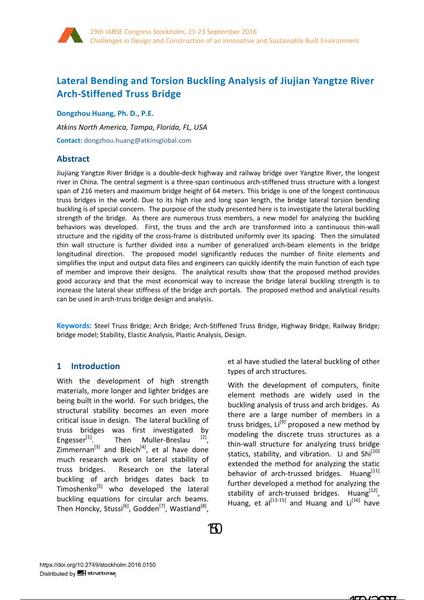Lateral Bending and Torsion Buckling Analysis of Jiujian Yangtze River Arch-Stiffened Truss Bridge

|
|
|||||||||||
Bibliographic Details
| Author(s): |
Dongzhou Huang
(Atkins North America, Tampa, Florida, FL, USA)
|
||||
|---|---|---|---|---|---|
| Medium: | conference paper | ||||
| Language(s): | English | ||||
| Conference: | IABSE Congress: Challenges in Design and Construction of an Innovative and Sustainable Built Environment, Stockholm, Sweden, 21-23 September 2016 | ||||
| Published in: | IABSE Congress Stockholm, 2016 | ||||
|
|||||
| Page(s): | 150-157 | ||||
| Total no. of pages: | 8 | ||||
| Year: | 2016 | ||||
| DOI: | 10.2749/stockholm.2016.0150 | ||||
| Abstract: |
Jiujiang Yangtze River Bridge is a double-deck highway and railway bridge over Yangtze River, the longest river in China. The central segment is a three-span continuous arch-stiffened truss structure with a longest span of 216 meters and maximum bridge height of 64 meters. This bridge is one of the longest continuous truss bridges in the world. Due to its high rise and long span length, the bridge lateral torsion bending buckling is of special concern. The purpose of the study presented here is to investigate the lateral buckling strength of the bridge. As there are numerous truss members, a new model for analyzing the buckling behaviors was developed. First, the truss and the arch are transformed into a continuous thin-wall structure and the rigidity of the cross-frame is distributed uniformly over its spacing. Then the simulated thin wall structure is further divided into a number of generalized arch-beam elements in the bridge longitudinal direction. The proposed model significantly reduces the number of finite elements and simplifies the input and output data files and engineers can quickly identify the main function of each type of member and improve their designs. The analytical results show that the proposed method provides good accuracy and that the most economical way to increase the bridge lateral buckling strength is to increase the lateral shear stiffness of the bridge arch portals. The proposed method and analytical results can be used in arch-truss bridge design and analysis. |
||||
| Keywords: |
design stability highway bridge arch bridge railroad bridge rail bridge plastic analysis Steel Truss Bridge Arch-Stiffened Truss Bridge bridge model elastic analysis
|
||||
